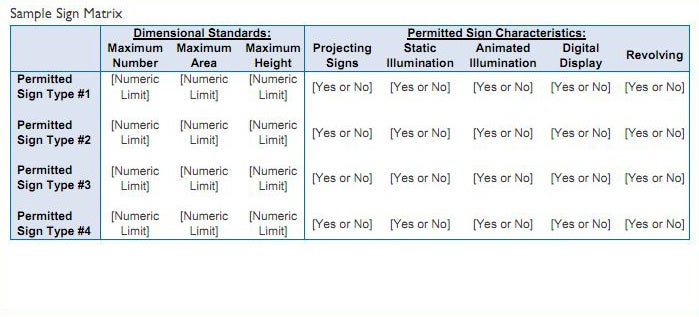Former ZCC members to reform sign regulations
Philadelphia’s current zoning code doesn’t know what a projecting sign is. Or, rather, it has several ideas about what a projecting sign is, but it hasn’t made up its mind.
Chapter 14-100 of the Code describes a projecting sign this way: “A sign which extends more than twelve inches from the building or structure wall, which uses a building or structure wall as its main source of support and whose copy is other than parallel to the building facing.”
Chapter 14-1900 describes it like this: “Any sign attached to a building or other structure which projects in such manner that both sides thereof are visible.”
This lack of definitional harmony is characteristic of a particularly mangled portion of Philadelphia’s famously mangled zoning code: sign controls. In part because these regulations are so contradictory, and spread throughout the whole code, the Zoning Code Commission decided to set them aside until after the bulk of the zoning code was rewritten.
Instead of wholly reforming sign regulations, the Commission simply condensed them into a single chapter and passed them along with the new code. It plans to send a chapter on sign regulations to City Council this spring, and have it approved before the new zoning code takes effect in August.
Technically speaking, however, the ZCC no longer exists. Its director, Eva Gladstein, has signed on with the Planning Commission as deputy director, and is organizing the sign control reform effort with former ZCC staffer Natalie Shieh and a group of volunteer Commissioners.
Last year, the Commission posted two information sheets to its website explaining the issues that need to be resolved over the next few months.
The first sheet is an assessment of the City’s existing regulations for accessory signs. (The Sign Control Work Plan Committee plans to deal with non-accessory signs later). It presents six Key Findings: (1) sign controls are poorly organized, (2) their definitions conflict, (3) it’s unclear what types of signs are allowed in what districts, (4) it’s unclear what sign characteristics are permitted, (5) the methods used for measuring the allowable size of signs are inconsistent, and (6) some regulations are missing.
The information sheet concludes that “the fundamental issue with the current code is the lack of a common method for regulating signs throughout the entire city.” Further, it resolves that reformed controls should be well-organized, define terms clearly, and implement consistent methods.
The second sheet suggests a framework for re-categorizing accessory signs, by breaking them down into six types and assigning them five possible characteristics. The sheet recommends that signs be categorized as Flat Wall, Angled Wall, Awning/Canopy, Marquee, Roof, or Freestanding. It suggests that these types be further defined by using the characteristics Projecting (single definition still pending), Static Illumination, Animated Illumination, Digital Display, and Revolving.
Gladstein told PlanPhilly that there is no fixed schedule for sign control reform at this time, but there will be two rounds of civic engagement as part of the process.
She said the first round will involve discussion groups with five different constituencies, such as civic associations and business groups. Gladstein she expects those meetings to start at the end of January. The second round, starting in the spring, will involve five community meetings.
The sign-control reform issue is bound to draw feedback from several interest groups, especially regarding Non-Accessory Signs.
For one, SCRUB, the Society Created to Reduce Urban Blight, has often lobbied against the proliferation of outdoor advertising. At a City Council meeting in December, SCRUB attorney Stephanie Kindt testified in opposition to a bill that would allow a large wall-wrap sign to be placed on a building on Spring Garden Street. City Council passed the bill, and Mayor Nutter later vetoed it.
Council President Darrell Clarke, on the other hand, has said he would like to sell advertising rights on portions of City-owned property to generate revenue.
Gladstein said the Planning Commission will devote portions of a few of its spring meetings to public comment on sign control reform.
Check back with PlanPhilly for full coverage of the process.
Contact the reporter at jaredbrey@gmail.com
WHYY is your source for fact-based, in-depth journalism and information. As a nonprofit organization, we rely on financial support from readers like you. Please give today.








